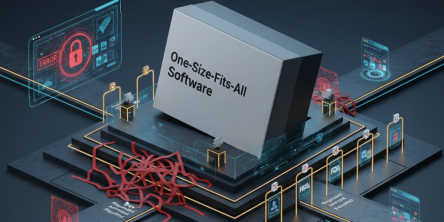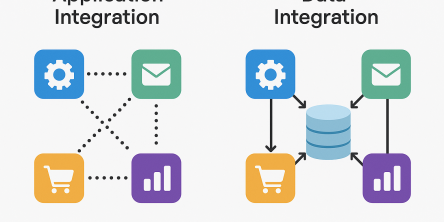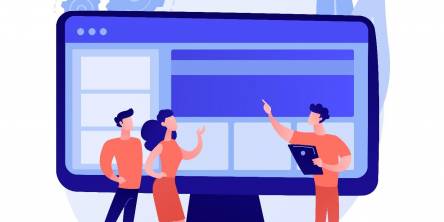Top 7 Practices for an Efficient Mobile App Onboarding

App onboarding is crucial as it decides the success or failure of the application. It is the first point of contact in a mobile app user’s journey. The onboarding process covers a series of screens. Its purpose is to educate users about the use of the app, allow them to register/login, and help them interact with the app as per their convenience. Therefore, it is vital to create a strong first impression to facilitate a positive, engaging user experience.
Why App Onboarding is Important
An effective onboarding enables businesses to optimize user interactions with the app. It helps to encourage users to keep the app on their devices and engage with it to change their lives for better.
Benefits of Mobile Application Onboarding
- Positive first impression after the app installation
- Users get more familiar about the app functionality and utilize it properly
- Businesses can increase app retention ratio and boost their conversion goals
Identify if Your App Needs Onboarding
Before jumping to create efficient onboarding experiences, you should know your app functions and how you can utilize the best onboarding practices.
For this, check the below elements and determine if they fit in your app developing strategy:
Your app has a complex workflow or if it is going to perform some complex processes
If you are redesigning your existing app and your customers need to be updated with new app features and enhancements
You are introducing a new concept, and your app users must get familiar with it
Your application mostly works on the user-generated data or has some specific interaction processes
Types of App Onboarding
Depending on your business model and app functionality, you can go for either of the three types of onboarding, as mentioned below:
- Benefits-Oriented - It demonstrates the value the user would get from the application to increase the conversion. In this approach, you focus on describing what the app does more than showing how to use it.
- Function-Oriented - Explaining the app functionality is the core focus when you go with this approach. It imparts knowledge about how users can get started with the app and how they can perform specific actions.
- Progressive - It means that the app users would see particular information as they navigate through the app progressively. It displays the relevant content based on the screen the user is on.
Mobile App Onboarding Best Practices
1. Focus on Value Proposition
As this screen is the first in your onboarding flow where your users get in touch with your app, encourage users by showing a strong value proposition of your mobile application. Rather than highlighting the app features, explain how the users can leverage the app benefits.
2. Ask Only the Must Need Information
To keep users engaged with your app, use the input fields as minimum as possible. Make sure the message tone is simple, quick, and to-the-point. Also, if your app needs to access device information such as location, and more, ask users to grant permission at the beginning of the onboarding flow. Avoid bombarding unnecessary questions and use as few words as possible.
3. Build a Quick & Simple Sign-Up Process
Make the sign-up process as fast and easy as possible. Integrate the option to use social media accounts like Twitter, Facebook, Google, and more to sign-up/login in your app.
If your app is relatively unknown to the users or you are introducing a new concept, don’t make the sign-up process mandatory at first. Provide the option to skip the app tour and sign-up process to let users navigate through essential functions of the app. If they find it engaging, they would be encouraged to create an account for accessing the whole app.
4. Create a Visual Appeal
The screens should be visually attractive to make people engaged with the application. You can opt for animations as well to create great impressions on users as they interact with the app screens.
5. Prioritize Personalization
Provide a customized experience right from the start of the onboarding process flow. You can offer choices based on the region, language, genre, and other factors to personalize the content of the app.
6. Create CTA
Include a CTA (Call to Action) to encourage users to take relevant actions. Create a well-designed, contextual CTA so that it can clarify users what they can do next.
7. Monitor & Track
Use heat maps, analytics, and other services to analyze the in-app behavior and gather insights about the user experience. Track in which areas users are interacting most with the app and where they opt-out during the onboarding process. Identify such potential pain points and enhance the onboarding flow accordingly.
Conclusion
Before finalizing the onboarding process, you should research about the user behavior, project scope, navigation options, app complexity, and other factors. A reliable partner with custom mobile application development experience can help implement the right-fit practices for your app onboarding. Though onboarding is not the only factor that impacts app success, an efficient process can double the chances of your application’s popularity.
Similar Articles
At first glance, off-the-shelf software appears to be a dream come true. They are quick to set up, cheaper upfront, and marketed as “universal.”
A modern business must continually adapt. This bit everyone seems to know.
The modern healthcare industry is undergoing a significant transformation. The models of healthcare that we are used to thus far are now making way for a more data driven approach
In the modern world, maintaining good health often feels like a constant challenge. Between busy lifestyles, sedentary habits, and lack of motivation, many people find it difficult to stay consistent with exercise, diet, or wellness practices.
Every news publisher's dream, or just getting started, hits that wall sooner or later. What do you build your site on? You’ve basically got two roads: WordPress or custom development.
Discover key features construction teams need in permit tracking software to boost efficiency, stay compliant, and streamline project management.
Thanks to cloud computing, specialized SaaS apps have become rather accessible.
Let’s be honest – managing royalties isn’t exactly the fun part of working in media or publishing, but it is very important because it protects the creator’s rights and work ownership.
The Software as a Service (SaaS) industry continues to transform before 2025 which creates new obstacles for business operations.








